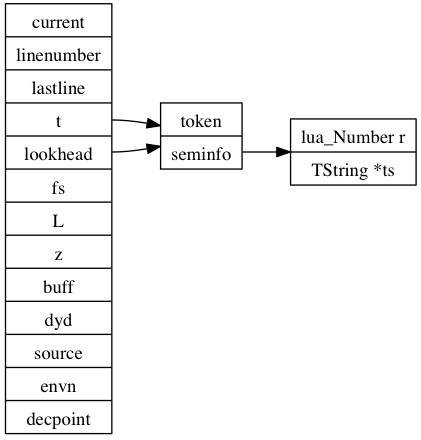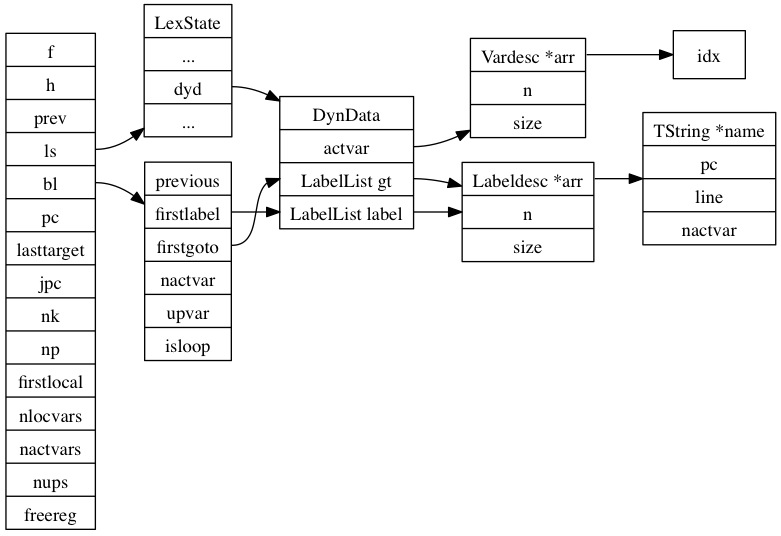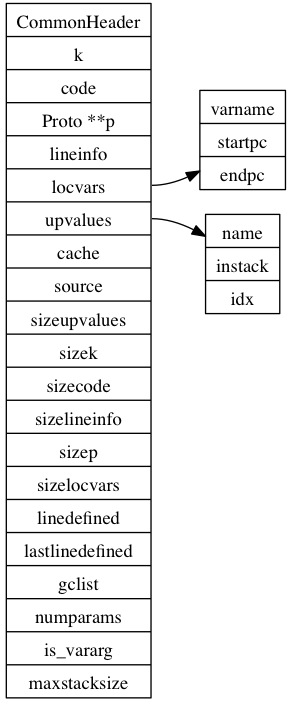接上一篇:lua源码剖析(一)
词法分析
lua对与每一个文件(chunk)建立一个LexState来做词法分析的context数据,此结构定义在llex.h中。词法分析根据语法分析的需求有当前token,有lookahead token,LexState结构如图:

其中token结构中用int存储实际token值,此token值对于单字符token(+ - * /之类)就表示自身,对于多字符(关键字等)token是起始值为257的枚举值,在llex.h文件中定义:
#define FIRST_RESERVED 257
/*
* WARNING: if you change the order of this enumeration,
* grep "ORDER RESERVED"
*/enum RESERVED {
/* terminal symbols denoted by reserved words */ TK_AND = FIRST_RESERVED, TK_BREAK,
TK_DO, TK_ELSE, TK_ELSEIF, TK_END, TK_FALSE, TK_FOR, TK_FUNCTION,
TK_GOTO, TK_IF, TK_IN, TK_LOCAL, TK_NIL, TK_NOT, TK_OR, TK_REPEAT,
TK_RETURN, TK_THEN, TK_TRUE, TK_UNTIL, TK_WHILE,
/* other terminal symbols */ TK_CONCAT, TK_DOTS, TK_EQ, TK_GE, TK_LE, TK_NE, TK_DBCOLON, TK_EOS,
TK_NUMBER, TK_NAME, TK_STRING
};
token结构中还有一个成员seminfo,这个表示语义信息,根据token的类型,可以表示数值或者字符串。
lex提供函数luaX_next和luaX_lookahead分别lex下一个token和lookahead token,在内部是通过llex函数来完成词法分析。
语法分析
lua语法分析是从lparser.c中的luaY_parser开始:
Closure *luaY_parser (lua_State *L, ZIO *z, Mbuffer *buff,
Dyndata *dyd, const char *name, int firstchar) {
LexState lexstate;
FuncState funcstate;
Closure *cl = luaF_newLclosure(L, 1); /* create main closure */
/* anchor closure (to avoid being collected) */
setclLvalue(L, L->top, cl);
incr_top(L);
funcstate.f = cl->l.p = luaF_newproto(L);
funcstate.f->source = luaS_new(L, name); /* create and anchor TString */
lexstate.buff = buff;
lexstate.dyd = dyd;
dyd->actvar.n = dyd->gt.n = dyd->label.n = 0;
luaX_setinput(L, &lexstate, z, funcstate.f->source, firstchar);
mainfunc(&lexstate, &funcstate);
lua_assert(!funcstate.prev && funcstate.nups == 1 && !lexstate.fs);
/* all scopes should be correctly finished */
lua_assert(dyd->actvar.n == 0 && dyd->gt.n == 0 && dyd->label.n == 0);
return cl; /* it's on the stack too */
}
此函数创建一个closure并把LexState和FuncState初始化后调用mainfunc开始parse,其中FuncState表示parse时函数状态信息的,如图:

每当parse到一个function的时候都会建立一个FuncState结构,并将它与所嵌套的函数通过prev指针串联起来,body函数就是完成嵌套函数parse。
static void body (LexState *ls, exposed *e, int ismethod, int line) {
/* body -> `(' parlist `)' block END */
FuncState new_fs;
BlockCnt bl;
new_fs.f = addprototype(ls);
new_fs.f->linedefined = line;
open_func(ls, &new_fs, &bl);
checknext(ls, '(');
if (ismethod) {
new_localvarliteral(ls, "self"); /* create 'self' parameter */
adjustlocalvars(ls, 1);
}
parlist(ls);
checknext(ls, ')');
statlist(ls);
new_fs.f->lastlinedefined = ls->linenumber;
check_match(ls, TK_END, TK_FUNCTION, line);
codeclosure(ls, e);
close_func(ls);
}
FuncState中的f指向这个函数的Proto,Proto中保存着函数的指令、变量信息、upvalue信息等其它信息,Proto的结构如图:

k指向一个这个Proto中使用到的常量,code指向这个Proto的指令数组,Proto **p指向这个Proto内部的Proto列表,locvars存储local变量信息,upvalues存储upvalue的信息,cache指向最后创建的closure,source指向这个Proto所属的文件名,后面的size*分别表示前面各个指针指向的数组的大小,numparams表示固定的参数的个数,is_vararg表示这个Proto是否是一个变参函数,maxstacksize表示最大stack大小。
FuncState中的ls指向LexState,在LexState中有一个Dyndata的结构,这个结构用于保存在parse一个chunk的时候所存储的gt label list和label list以及所有active变量列表,其中gt label list存储的是未匹配的goto语句和break语句的label信息,而label list存储的是已声明的label。待出现一个gt label的时候就在label list中查找是否有匹配的label,若出现一个label也将在gt label list中查找是否有匹配的gt。
LuaY_parser调用mainfunc开始parse一个chunk:
static void mainfunc (LexState *ls, FuncState *fs) {
BlockCnt bl;
expdesc v;
open_func(ls, fs, &bl);
fs->f->is_vararg = 1;
/* main function is always vararg */ init_exp(&v, VLOCAL, 0);
/* create and */
*/ newupvalue(fs, ls->envn, &v);
/*  set environment upvalue */
set environment upvalue */ luaX_next(ls);
/* read first token */ statlist(ls);
/* parse main body */ check(ls, TK_EOS);
close_func(ls);
}
在mainfunc中通过open_func函数完成对进入某个函数进行parse之前的初始化操作,每parse进一个block的时候,将建立一个BlockCnt的结构并与上一个BlockCnt连接起来,当parse完一个block的时候就回弹出最后一个BlockCnt结构。BlockCnt结构中的其它变量的意思是:nactvar表示这个block之前的active var的个数,upval表示这个block是否有upvalue被其它block访问,isloop表示这个block是否是循环block。mainfunc中调用statlist,statlist调用statement开始parse语句和表达式。
statement分析语句采用的是LL(2)的递归下降语法分析法。在statement里面通过case语句处理各个带关键字的语句,在default语句中处理赋值和函数调用的分析。语句中的表达式通过expr函数处理,其处理的BNF如下:
exp ::= nil | false | true | Number | String | ‘...’ | functiondef |
prefixexp | tableconstructor | exp binop exp | unop exp
expr函数调用subexpr函数完成处理。
static BinOpr subexpr (LexState *ls, expdesc *v, int limit) {
BinOpr op;
UnOpr uop;
enterlevel(ls);
uop = getunopr(ls->t.token);
if (uop != OPR_NOUNOPR) {
int line = ls->linenumber;
luaX_next(ls);
subexpr(ls, v, UNARY_PRIORITY);
luaK_prefix(ls->fs, uop, v, line);
}
else simpleexp(ls, v);
/* expand while operators have priorities higher than `limit' */
op = getbinopr(ls->t.token);
while (op != OPR_NOBINOPR && priority[op].left > limit) {
expdesc v2;
BinOpr nextop;
int line = ls->linenumber;
luaX_next(ls);
luaK_infix(ls->fs, op, v);
/* read sub-expression with higher priority */
nextop = subexpr(ls, &v2, priority[op].right);
luaK_posfix(ls->fs, op, v, &v2, line);
op = nextop;
}
leavelevel(ls);
return op; /* return first untreated operator */
}
当分析exp binop exp | unop exp的时候lua采用的是算符优先分析,其各个运算符的优先级定义如下:
static const struct {
lu_byte left; /* left priority for each binary operator */
lu_byte right; /* right priority */
} priority[] = { /* ORDER OPR */
{6, 6}, {6, 6}, {7, 7}, {7, 7}, {7, 7}, /* `+' `-' `*' `/' `%' */
{10, 9}, {5, 4}, /* ^, .. (right associative) */
{3, 3}, {3, 3}, {3, 3}, /* ==, <, <= */
{3, 3}, {3, 3}, {3, 3}, /* ~=, >, >= */
{2, 2}, {1, 1} /* and, or */
};
#define UNARY_PRIORITY 8 /* priority for unary operators */
代码生成
lua代码生成是伴随着语法分析进行的,指令类型Instruction定义在llimits.h中:
/*
** type for virtual-machine instructions
** must be an unsigned with (at least) 4 bytes (see details in lopcodes.h)
*/
typedef lu_int32 Instruction;

Instruction是一个32位的整形数据,其中0~5 bits表示optype,6~13 bits参数A,14~22 bits表示参数B,23~31 bits表示参数C,14~31 bits表示参数Bx或sBx,6~31 bits表示参数Ax。
代码生成的函数声明在lcode.h中,以luaK开头,这一系列的函数大多都有expdesc *v的参数,expdesc的结构定义在lparser.h,如下:
typedef struct expdesc {
expkind k;
union {
struct { /* for indexed variables (VINDEXED) */
short idx; /* index (R/K) */
lu_byte t; /* table (register or upvalue) */
lu_byte vt; /* whether 't' is register (VLOCAL) or upvalue (VUPVAL) */
} ind;
int info; /* for generic use */
lua_Number nval; /* for VKNUM */
} u;
int t; /* patch list of `exit when true' */
int f; /* patch list of `exit when false' */
} expdesc;
expdesc中的t和f分别表示表达式为true和false时,待回填跳转指令的下标。k表示表达式的类型,u表示对应类型的数据。
代码生成过程中根据表达式类型做相应的代码生成操作,lua中每个函数最大有250个寄存器,表达式的计算就是选择这些寄存器存放并生成数据,而寄存器的下标是在代码生成阶段选择好的,寄存器的释放是根据变量和表达式的生命周期结束的时候释放。代码生成过程会将变量的生命周期的起始pc和结束指令pc分别存放在Proto中的LocVar的startpc和endpc里面,供调试使用。
posted on 2012-08-12 17:28
airtrack 阅读(8619)
评论(0) 编辑 收藏 引用